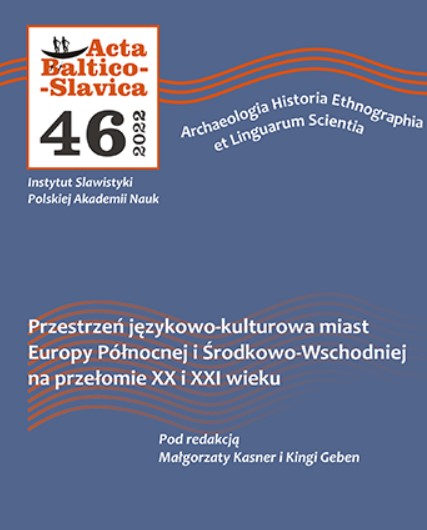Mitonimia międzywojennego Kowna
Mythonymy of Interwar Kaunas
Author(s): Justyna PrusinowskaSubject(s): Rural and urban sociology, Transformation Period (1990 - 2010), Politics of History/Memory, Politics and Identity
Published by: Instytut Slawistyki Polskiej Akademii Nauk
Keywords: mythonyms; Lithuanian mythology; Kaunas; cultural landscape; urban landscape; collective memory; national identity;
Summary/Abstract: The present article describes and examines the lexical tissue of the city of Kaunas related to the pagan past of the Balts – Prussians and Lithuanians. The mythonyms appear basically in three periods of the city’s existence: in the interwar period, at the turn of the 1990s and after 2004, i.e. at critical and borderline moments, when emphasising individuality, exposing identity and referring to its sources was of utmost importance. The most interesting phenomena took place in the interwar period, when by placing in the city tissue numerous objects with names borrowed from Baltic mythology, collective memory was clearly shaped and mobilised in the space previously marked by “strangers” – Imperial Russia and the German Empire. In this way, this space was effectively tamed. The importance of this process is evidenced by dozens of names associated with the pagan Balts (Kaunas is a phenomenon in this respect on the map of Lithuania), which were given in the interwar period mostly to streets and buildings located, importantly, in the then very centre of the city. In the other two periods, mythonyms were not so popular anymore: the names of deities and other creatures historically worshiped by Lithuanians were usually given to streets far away from the city centre, often in newly created districts. Thanks to this, however, Kaunas has a clearly drawn identity that spreads from the centre towards the suburbs. A place that is thoroughly permeated with the “spirit of Lithuanianness” is the Unity Square (Lith. Vienybės aikštė), scrupulously cleansed of the traces of the aforementioned dependencies, whose important point is an inconspicuous dwarf who watches over the symbolic spring of the Lithuanian nation. It is this mythonymic element that is treated with special attention in this article, and on its example, a detailed cultural analysis of the city’s space is proposed. It should be emphasised that in Kaunas the mythonyms form a thought-out, multi-layered structure, as if a separate city that is inaccessible and foreign to the strangers. The study discusses individual collections and elements of this extensive web of meanings, deliberately created by town planners and urban designers, the basis of which is the historical experience of Kaunas and Lithuania.
Journal: Acta Baltico Slavica
- Issue Year: 2022
- Issue No: 46
- Page Range: 1-17
- Page Count: 17
- Language: Polish

